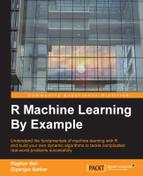Data science and machine learning are some of the top buzzwords in the technical world today. From retail stores to Fortune 500 companies, everyone is working hard to make machine learning give them data-driven insights to grow their businesses. With powerful data manipulation features, machine learning packages, and an active developer community, R empowers users to build sophisticated machine learning systems to solve real-world data problems.
This book takes you on a data-driven journey that starts with the very basics of R and machine learning and gradually builds upon the concepts to work on projects that tackle real-world problems.
Chapter 1, Getting Started with R and Machine Learning, acquaints you with the book and helps you reacquaint yourself with R and its basics. This chapter also provides you with a short introduction to machine learning.
Chapter 2, Let's Help Machines Learn, dives into machine learning by explaining the concepts that form its base. You are also presented with various types of learning algorithms, along with some real-world examples.
Chapter 3, Predicting Customer Shopping Trends with Market Basket Analysis, starts off with our first project, e-commerce product recommendations, predictions, and pattern analysis, using various machine learning techniques. This chapter specifically deals with market basket analysis and association rule mining to detect customer shopping patterns and trends and make product predictions and suggestions using these techniques. These techniques are used widely by retail companies and e-commerce stores such as Target, Macy's, Flipkart, and Amazon for product recommendations.
Chapter 4, Building a Product Recommendation System, covers the second part of our first project on e-commerce product recommendations, predictions, and pattern analysis. This chapter specifically deals with analyzing e-commerce product reviews and ratings by different users, using algorithms and techniques such as user-collaborative filtering to design a recommender system that is production ready.
Chapter 5, Credit Risk Detection and Prediction – Descriptive Analytics, starts off with our second project, applying machine learning to a complex financial scenario where we deal with credit risk detection and prediction. This chapter specifically deals with introducing the main objective, looking at a financial credit dataset for 1,000 people who have applied for loans from a bank. We will use machine learning techniques to detect people who are potential credit risks and may not be able to repay a loan if they take it from the bank, and also predict the same for the future. The chapter will also talk in detail about our dataset, the main challenges when dealing with data, the main features of the dataset, and exploratory and descriptive analytics on the data. It will conclude with the best machine learning techniques suitable for tackling this problem.
Chapter 6, Credit Risk Detection and Prediction – Predictive Analytics, starts from where we left off in the previous chapter about descriptive analytics with looking at using predictive analytics. Here, we specifically deal with using several machine learning algorithms to detect and predict which customers would be potential credit risks and might not be likely to repay a loan to the bank if they take it. This would ultimately help the bank make data-driven decisions as to whether to approve the loan or not. We will be covering several supervised learning algorithms and compare their performance. Different metrics for evaluating the efficiency and accuracy of various machine learning algorithms will also be covered here.
Chapter 7, Social Media Analysis – Analyzing Twitter Data, introduces the world of social media analytics. We begin with an introduction to the world of social media and the process of collecting data through Twitter's APIs. The chapter will walk you through the process of mining useful information from tweets, including visualizing Twitter data with real-world examples, clustering and topic modeling of tweets, the present challenges and complexities, and strategies to address these issues. We show by example how some powerful measures can be computed using Twitter data.
Chapter 8, Sentiment Analysis of Twitter Data, builds upon the knowledge of Twitter APIs to work on a project for analyzing sentiments in tweets. This project presents multiple machine learning algorithms for the classification of tweets based on the sentiments inferred. This chapter will also present these results in a comparative manner and help you understand the workings and difference in results of these algorithms.
